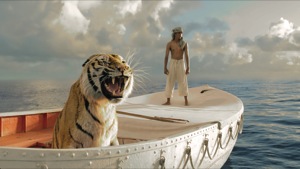
When you begin a novel with “I have a story that will make you believe in God,” you have made a bold promise that is very likely to be left unfulfilled. But that is how Yann Martel begins the Booker Prize-winning Life of Pi, with the narrator explaining that an old man has told him this story with just such a lofty goal.
The film version of Life of Pi, directed by Ang Lee and written by David Magee, begins similarly, with Pi Patel (Irrfan Khan) telling his life story to a writer (Rafe Spall), who had heard from an old man in India that Pi’s story would make him believe in God.
That the film failed to make me believe in God, and I venture to bet that it failed to convert anyone else, is not surprising. But I was surprised that it was only the film’s photography that inspired and moved, while the story left me rather disturbed.
Despite the incredible complexity of a story being told within a story within another story, the film is not hard to follow. A boy named Pi (short for Piscine Molitor Patel) grows up in Pondicherry, India, where his parents (Adil Hussain and Tabu) ran a small zoo.
As a child, he is fascinated by religion, having been raised Hindu while also absorbing Islam and Christianity.
As a teen (now played by preternaturally talented Suraj Sharma), his parents decide to sell the animals and move to Canada, and they set off on a Japanese cargo ship.
Sailing over the Mariana Trench, the deepest part of the world’s oceans, the ship is hit by a terrible storm, and it sinks.
Pi is the only human to make it to a life boat; he is joined by several of the zoo’s charges, a zebra, an orangutan and a hyena.
After a day, he discovers that the zoo’s tiger is on the boat, too, hidden under the tarp. Soon, only the tiger and Pi are left, with Pi escaping the tiger’s hungry jaws only by living on a raft tethered to the boat. The rest of the film focuses on the relationship between Pi and the tiger the zoo had named Richard Parker, how Pi trains (in a way) Richard Parker, and how they survive crossing the Pacific Ocean, finally coming ashore in Mexico after 227 days.
Throughout, Pi talks to God, asking him why he has put Pi through these trials. That Pi, as an adult, teaches religion and continues to believe in Hinduism, Islam and Christianity seems to indicate that in some way, God has answered Pi to Pi’s satisfaction.
To mine, not so much. While there are allusions aplenty to Jonah and the whale, to Hemmingway’s Old Man and the Sea, to Job and to tales of Vishnu, what Pi and Richard Parker’s ordeal means is not clear. And when the ending’s twist is revealed, the story becomes even more murky, if not opaque.
I blame the film’s lack of theological profundity on David Magee’s adaptation, which underemphasizes Martel’s philosophical insights while overemphasizing Pi’s story of survival. Ang Lee and his cinematographer Claudia Miranda, however, overcome Magee’s script to produce the most visually stunning film since Avatar.
The technical marvel of Richard Parker does not surpass Caesar in Rise of the Planet of the Apes, but it is close; at no point do you doubt that Pi and Richard Parker are on the same boat and that Pi has every reason to fear for his life. The entirely computer-generated seascape, ocean waves, storm clouds and copious amounts of flora and fauna are also intricately and fantastically detailed.
The beauty of Lee and Miranda’s shots may not make you believe in God, even though, to me, they seemed almost divinely inspired.
MOVIE REVIEW
Life of Pi
Directed by Ang Lee
Written David Magee
Starring Suraj Sharma, Irrfan Khan and Tabu
Rated PG
At your local multiplex











